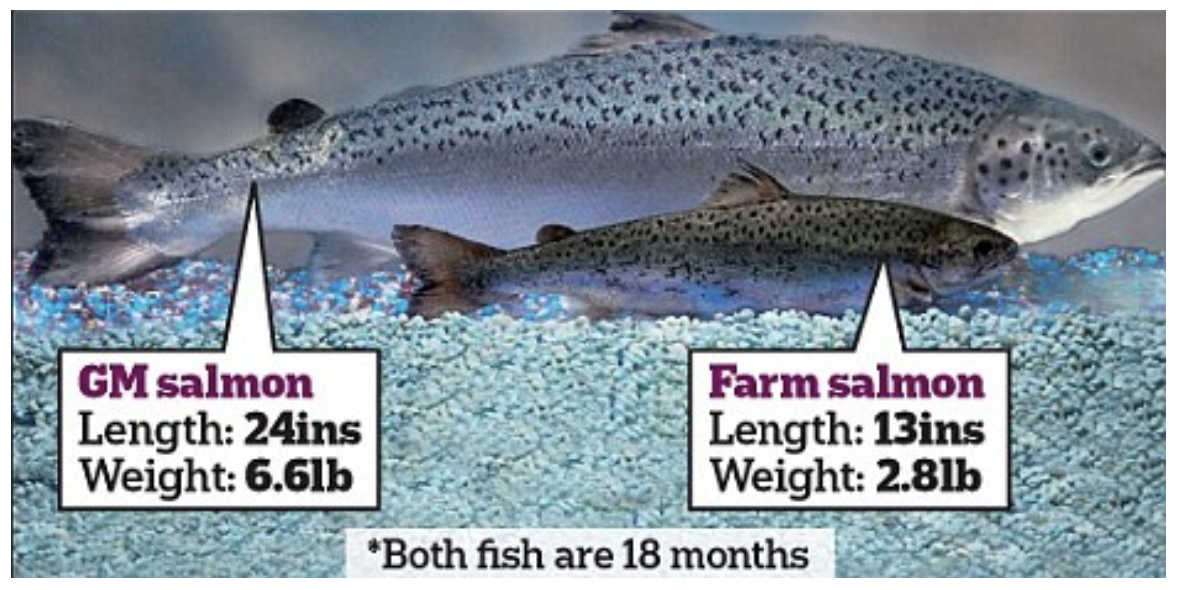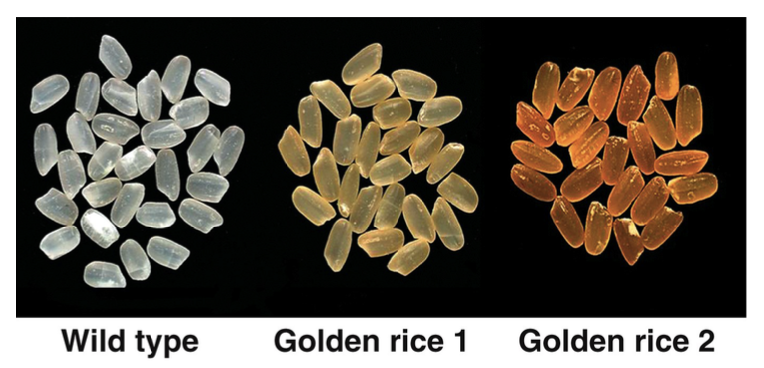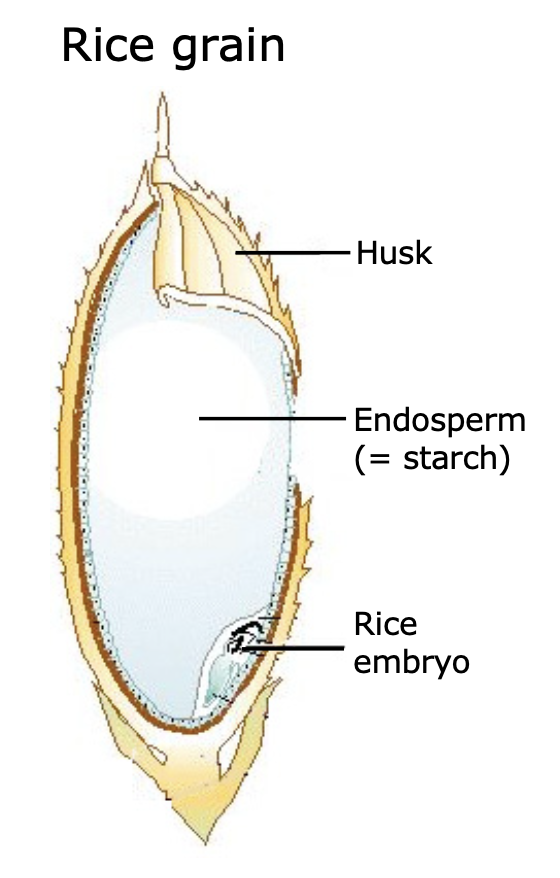MCB 250 – Gene Therapy and Genetically Modified Organisms
1/23
Earn XP
Description and Tags
Module 35: Most genetically modified organisms are used in laboratory research • Name three examples of genetically modified crops/livestock that benefit the food supply/human health and how those modifications were made • Name three medical conditions that can be corrected with gene therapy, and how they are corrected • Why did one gene therapy trial go awry? • Know why choice of vector and promoter are critical to gene therapy
Name | Mastery | Learn | Test | Matching | Spaced |
|---|
No study sessions yet.
24 Terms
The transgenic growth hormone gene in the AquaAdvantage salmon came from which organism?
a. Salmon
b. Bacteria
c. Cow
d. Daffodil
a. Salmon
In Golden Rice, the missing enzymes needed to synthesize b-carotene are expressed under the control of a promoter that drives expression in which part of the rice plant?
a. Endosperm
b. Husk
c. Rice embryo
d. Kernel
a. Endosperm
Gene therapy is appropriate for treating conditions that are:
a. Due to complex multi-genic effects
b. Due to loss of function of a single gene
c. Caused by transposon insertions in regulatory regions
d. Caused by a mutation that induces over-expression of a deleterious gene, such as an oncogene
b. Due to loss of function of a single gene
What unwanted side effects could gene therapy cause?
a. Graft-vs-Host disease
b. Severe allergic reaction
c. Immune rejection
d. Insertional mutagenesis of a critical gene or critical regulatory region
d. Insertional mutagenesis of a critical gene or critical regulatory region
Why is it easier to carry out gene therapy on blood cells and hematopoietic stem cells?
a. They integrate foreign DNA more readily into the genome
b. They can be removed from the body, modified in the laboratory, and returned to the body
c. There are more viral vectors that target blood cells
d. There are many strong promoters that can be used in blood cells
b. They can be removed from the body, modified in the laboratory, and returned to the body
Why do salmon only grow during the summer?
A. There is only enough food to sustain salmon growth during the summer
B. The salmon needs a certain amount of sunlight to stimulate growth
C. The salmon have a mutation in their growth hormone gene
D. The salmon growth hormone gene is only expressed in the summer months
D. The salmon growth hormone gene is only expressed in the summer months
Where did scientists obtain a promoter they knew would be expressed year-round?
A. From a constitutively expressed salmon gene
B. From a constitutively expressed ocean pout gene
C. From a bacterial plasmid
D. From a strong viral regulatory region
B. From a constitutively expressed ocean pout gene
Which organization approves and regulates food sold in the US and medical treatments?
A. The Food and Drug Administration
B. The Consumer Protection Agency
C. The National Institutes of Health
D. Homeland Security
A. The Food and Drug Administration
Golden Rice contains transgenic enzymes that are part of the pathway that produces which molecule?
A. Vitamin A
B. β-carotene
C. Ascorbic acid
D. Vitamin C
B. β-carotene
In addition to identifying the right coding region, what other critical part of a transgene must scientists consider?
A. Codon optimization
B. Transcription terminator
C. Promoter
D. Splicing variants
C. Promoter
What are the critical characteristics of a promoter chosen for a transgene?
A. It must be constitutively active
B. It must not regulate surrounding endogenous genes
C. It must drive expression in the right time and place for the purpose of that transgene
D. It must be able to be silenced if needed
C. It must drive expression in the right time and place for the purpose of that transgene
What is the source of the transgene expressed in the Rainbow Papaya?
A. The Kapoho papaya
B. Another plant resistant to the Ringspot Virus
C. The Ringspot Virus
D. Aphids
C. The Ringspot Virus
Select all that apply: What made SCID uniquely accessible for gene therapy?
A. It is caused by mutation in a single gene
B. It affects immune cells (blood cells)
C. It affects children, who are more amenable to genetic manipulation
D. Transgenic stem cells can provide an unlimited supply of “corrected” immune cells
E. It can be accomplished through bone marrow transplantation
A. It is caused by mutation in a single gene
B. It affects immune cells (blood cells)
D. Transgenic stem cells can provide an unlimited supply of “corrected” immune cells
For the first gene therapy trial to correct SCID, where was the promoter taken from?
A. The endogenous ADA gene
B. A constitutively expressed human gene
C. The ocean pout
D. A virus
A. The endogenous ADA gene
Which of the following statements about insertional mutagenesis is false?
A) Insertional mutagenesis can result from insertion into an intron.
B) The inserted DNA can disrupt the open-reading frame (ORF) of a protein-coding gene.
C) The inserted DNA can interfere with the regulation of a gene’s transcription.
D) Insertion must occur within the protein-coding (or RNA-coding) region of a gene in order to produce a mutant phenotype.
D) Insertion must occur within the protein-coding (or RNA-coding) region of a gene in order to produce a mutant phenotype.
For gene therapy to correct Leber’s Congenital Amaurosis, what promoter was used to drive expression of the RPE65A gene?
A. The endogenous RPE65A promoter
B. A promoter from a constitutively expressed human gene
C. An ocean pout promoter
D. A strong viral promoter
Why didn’t they use a strong viral promoter?
A. They wanted to be able to switch expression on and off
B. They were concerned about unwanted effects that could occur if the viral vector that carried the gene therapy integrated in a regulatory region for another gene
C. They couldn’t control which cells took up the viral vector, and they only wanted the gene expressed in photoreceptor cells
D. They only wanted expression during childhood.
A. The endogenous RPE65A promoter
B. They were concerned about unwanted effects that could occur if the viral vector that carried the gene therapy integrated in a regulatory region for another gene
When correcting a tissue that is continually replenished, which cells must the gene therapy target?
A. The photoreceptors
B. The epithelial cells
C. The T cells
D. The stem cells
D. The stem cells
what are GMOs used for? give examples
agriculture: to genetically improve crops and livestock
AquaAdvantage Salmon
Golden Rice
Rainbow Papaya
industry: to produce and sell pharmaceutical drugs synthesized from cloned genes
insulin
gene therapy: the genetic modification of humans or human cells in order to improve disease conditions → current approved gene therapy procedures are restricted to somatic tissues, and thus do not produce heritable changes in the genome
Severe Combined Immunodeficiency (SCID)
hereditary blindness
cancer
epidermolysis bullosa

AquaAdvantage salmon (issue and solution)
a breed of genetically modified Atlantic salmon
issue: salmon primarily grow during summer months because that is the only time their pituitary glands produce growth hormone → takes 3 years for hatchling to grow to full adult size
solution:
AquaBounty (company) isolated a cDNA encoding salmon growth hormone
then cloned it into a plasmid with the ocean pout’s antifreeze gene which has a strong, constitutive promoter transcribed year round
the fusion gene was injected into fertilized salmon eggs → some embryos inserted the transgene into their chromosomal DNA
experiment was a success → continuous expression of growth hormone allowed the genetically modified salmon to reach adult size in half the time

golden rice (issue and solution)
issue: the endosperm (starch) in WT rice does not express the two enzymes essential for the biosynthesis of β-carotene, which is the precursor for vitamin A
solution:
cloned genes for the two necessary biosynthetic enzymes were obtained (1 from daffodil and 1 from a bacterium)
these genes were each fused with a promoter sequence known the drive transcription in the endosperm
these fusion genes were introduced into the rice genome as transgenes

rainbow papaya (issue and solution)
issue: ringspot virus is lethal to papaya plants, spread quickly, and cannot be controlled by culling diseased trees
solution: (similar to vaccinations in humans)
coat protein of the ringspot virus is expressed in the papaya plant → this confers resistance to virulent ringspot virus
the rainbow papaya is a F1 hybrid of a transgenic papaya (Sunset) and non-transgenic papaya (Kapoho)
severe combined immunodeficiency (SCID)
a condition in which the immune system fails due to a lack of functioning lymphocytes → patients are at constant risk of fatal infection by viruses and bacteria that do not seriously affect most people
issue for Ashanti:
she was homozygous for loss-of-function alleles of a gene that encodes the enzyme adenine deaminase (ADA)
without ADA, T lymphocytes are severely disabled with a severely shortened life span
solution:
ADA-deficient T lymphocytes were isolated from samples of her blood
these T cells were genetically modified by integrating a cloned copy of the WT ADA gene into their genome using a genetically engineered retrovirus as the vector
these genetically modified T cells were reintroduced into Ashanti’s bloodstream
hereditary blindness (issue and solution)
gene therapy was successful in partially rescuing vision in patients suffering from a type of hereditary blindness
issue: patients homozygous deficient for the enzyme RPE65A were not able to synthesize visual pigments in the retina
solution:
a viral vector carrying the WT RPE65A gene was injected into the eye
this transgene was under the control of its own WT promoter and was ∴ only expressed in the photoreceptor cells were this protein is normally made
epidermolysis bullosa (issue and solution)
issue: a skin blistering disease caused by mutations in Laminin B3, which causes cell layers to not adhere
solution:
harvest healthy skin on patient
introduce functional copy of LAMB3 into patient’s own skin cells (some will be stem cells)
grow skin from these cells in culture
graft stem cell-derived skin to severely blistered area
corrected stem cells will take over the replenishment of the skin